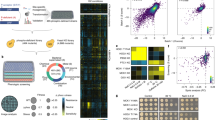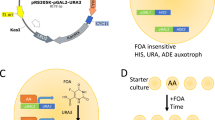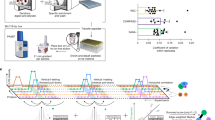Abstract
Dominant negative polypeptides can inhibit protein function by binding to a wild-type subunit or by titrating a ligand. Here we use high-throughput sequencing of libraries composed of fragments of yeast genes to identify polypeptides that act in a dominant negative manner, in that they are depleted during cell growth. The method can uncover numerous inhibitory polypeptides for a protein and thereby define small inhibitory regions, even pinpointing individual residues with critical functional roles.
This is a preview of subscription content, access via your institution
Access options
Access Nature and 54 other Nature Portfolio journals
Get Nature+, our best-value online-access subscription
$29.99 / 30 days
cancel any time
Subscribe to this journal
Receive 12 print issues and online access
$259.00 per year
only $21.58 per issue
Buy this article
- Purchase on Springer Link
- Instant access to full article PDF
Prices may be subject to local taxes which are calculated during checkout



Similar content being viewed by others
Data availability
High-throughput sequencing reads have been submitted to NCBI SRA under accession numbers SRR8573191–SRR8573214.
References
Herskowitz, I. Nature 329, 219–222 (1987).
Akada, R., Yamamoto, J. & Yamashita, I. Mol. Gen. Genet. 254, 267–274 (1997).
Ramer, S. W., Elledge, S. J. & Davis, R. W. Proc. Natl. Acad. Sci. USA 89, 11589–11593 (1992).
Stevenson, L. F., Kennedy, B. K. & Harlow, E. Proc. Natl. Acad. Sci. USA 98, 3946–3951 (2001).
Boyer, J. et al. Genome Biol. 5, R72 (2004).
Saldanha, A. J., Brauer, M. J. & Botstein, D. Mol. Biol. Cell 15, 4089–4104 (2004).
Lim, M. K. et al. Biochem. J. 435, 641–649 (2011).
Chan, K. K. et al. Biochemistry 48, 5518–5531 (2009).
Voellmy, R. Methods 35, 199–207 (2005).
Liu, X. D., Liu, P. C., Santoro, N. & Thiele, D. J. EMBO J. 16, 6466–6477 (1997).
Rabindran, S. K. et al. Science 259, 230–234 (1993).
Chen, Y., Barlev, Na, Westergaard, O. & Jakobsen, B. K. EMBO J. 12, 5007–5018 (1993).
Flick, K. E., Gonzalez, L., Harrison, C. J. & Nelson, H. C. M. J. Biol. Chem. 269, 12475–12481 (1994).
Yoshikawa, K. et al. Yeast 28, 349–361 (2011).
Armache, J.-P. et al. Proc. Natl. Acad. Sci. USA 107, 19748–19753 (2010).
Michaels, J. E. A., Schimmel, P., Shiba, K. & Miller, W. T. Proc. Natl. Acad. Sci. USA 93, 14452–14455 (1996).
Chow, C. Y. et al. Am. J. Hum. Genet. 84, 85–88 (2009).
Neudegger, T., Verghese, J., Hayer-Hartl, M., Hartl, F. U. & Bracher, A. Nat. Struct. Mol. Biol. 23, 140–146 (2016).
Quinlan, A. R. Curr. Protoc. Bioinformatics 47, 11.12.1–11.12.34 (2014).
Acknowledgements
We thank R. Waterston and E. Eichler for comments on the manuscript. The work was supported by NIH grant GM114166 to C.Q. and S.F., and NIH grant P41 GM103533 to S.F.
Author information
Authors and Affiliations
Contributions
M.W.D., C.Q. and S.F. conceived and interpreted experiments, and wrote the manuscript. M.W.D. conducted experiments and data analysis.
Corresponding author
Ethics declarations
Competing interests
The authors declare no competing interests.
Additional information
Publisher’s note: Springer Nature remains neutral with regard to jurisdictional claims in published maps and institutional affiliations.
Integrated supplementary information
Supplementary Figure 1 Reproducibility of individual fragment depletions and coverage values across Ura3 protein.
a, Bar plots showing library diversity pre- and post-induction. b, Scatter plot showing the enrichment scores (log2(frequencyout/frequencyin)) of each fragment of Ura3 across two biological replicates. Darker shades of blue indicate a higher density of points. c, Scatter plot showing frequencies of each Ura3 fragment in the output cell populations in two replicates. The strong density of points in the lower left corner of the plot indicates fragments that fully dropped out during the selection in media lacking uracil. d, Overlaid fragment coverage plots (as in Fig. 2b) generated from each of three replicates (shades of gray). e, Correlations of fragment depletion values between replicates from all experiments. f, Coverage plot as in Fig. 1b, calculated with different thresholds identifying depleted fragments.
Supplementary Figure 2 The smallest dominant negative peptides from Ura3.
Plot showing the 15 smallest and most depleted fragments from Ura3; y-axis shows the fragment enrichment score and x-axis indicates position in the Ura3 protein. The size (in amino acids) is shown beside each fragment, but all fragments contain peptide adaptors (see Methods), such that the full translated products range from 39 to 42 amino acids.
Supplementary Figure 3 Deleterious effects of dominant negative polypeptides of Ura3 are specific to media lacking uracil.
Growth rates of putative dominant negative and control fragments from the Ura3 selection experiment. Lines represent median values. a, Growth effects in the Ura3-dependent condition of media lacking uracil (reproduced from Fig. 1d for clarity). b, Growth effects of the same fragments in the Ura3-independent condition of media containing uracil (N = 11, 9, 11, 11 in order of plot).
Supplementary Figure 4 Analysis of cDNA fragment library.
a, Histogram showing the number of fragments per gene in the yeast genome. b, Histogram showing the sequencing depth for each putative dominant negative fragment. c, For each sequenced fragment, a slope was calculated on the basis of that fragment’s frequency before induction (input), after 1 d of growth selection and after 2 d of selection.
Supplementary Figure 5 Scheme for full-genome dominant negative fragment identification.
a, A yeast cDNA library generated from cells growing at 30 °C was used to generate a library of fragments cloned into a vector with galactose-inducible expression (as in Fig. 1a). After induced yeast cells containing this library have grown overnight, fragments from the output population are sequenced along with fragments from the pre-induction population to produce enrichment scores as in Fig. 1a. After identifying the reading frame and functional effect (depleted or neutral) of each fragment from the cDNA library, we aligned these fragments back to yeast genes. Fragment pileups from the in-frame depleted (red) were compared to pileups generated from two control sets: (1) in-frame neutral fragments (pink) and (2) out-of-frame depleted fragments (gray). Genes with dominant negative regions were identified as having a minimum of four (dashed line) overlapping in-frame depleted fragments, and as having regions where coverage of the control sets do not exceed the coverage of the in-frame depleted set. b, An example showing a gene with three putative dominant negative regions; in-frame depleted fragments are enriched only in the two regions near the C terminus.
Supplementary Figure 6 Scoring of genes with dominant negative regions from cDNA library.
a, Plot showing the 157 genes found to have a dominant negative regions ranked by the total number of individual dominant negative fragments found in those genes. b, Knockout growth effects are shown for the 157 genes with an identified dominant negative region compared to all tested genes; the dominant negative set shows a small enrichment for genes with deleterious effects on growth (one-sided t-test P = 0.024).
Supplementary Figure 7 Dominant negative coverage in protein components of the yeast ribosome.
Coverage charts (as in Fig. 3a) are shown for all ribosomal proteins in the yeast cDNA library screen identified to contain dominant negative regions. a, Those present in the cryo-EM structure of the translating yeast ribosome (PDB 4V6I) are shown. b,c, Those absent in the structure (b) or that derive from the mitochondrial ribosome (c) are also shown.
Supplementary Figure 8 Dominant negative regions in ribosomal proteins.
Ribosomal proteins were mapped onto the cryo-EM structure of the translating ribosome (PDB 4V6I), with the small subunit (40S) shown in gray, the large subunit (60S) in darker gray, the 18S and 25S rRNAs in gold, the P-site tRNA in blue, and proteins with dominant negative polypeptides in red. Around the structure are depletion plots that show domains in these proteins with overlapping dominant negative polypeptides. The y-axis of each depletion plot shows the coverage of overlapping fragments for in-frame depleted (red), in-frame neutral (pink), out-of-frame depleted (dark gray) and total fragments in all frames (light gray) (Methods, Supplementary Data 1).
Supplementary Figure 9 Several tRNA synthetases show overlapping dominant negative fragments in their C termini.
Coverage charts (as in Fig. 3b) are shown for all tRNA synthetase proteins in the yeast cDNA library screen identified as containing dominant negative regions. For these examples and the threonyl-tRNA synthetase shown in Fig. 3b, the dominant negative regions were found in the C-terminal end of the protein.
Supplementary Figure 10 Deleterious effects of dominant negative polypeptides are exacerbated in media in which the target gene is essential.
a, Coverage charts from the cDNA library selection in minimal media are shown for three genes related to amino acid metabolism. Our analysis identified each of these genes as having dominant negative regions. A representative fragment (indicated by red rectangles below coverage charts) was selected for each gene, and the polypeptide fragment was overexpressed in yeast cells. b–d, Bar plots showing growth rates of cells containing each dominant negative fragment grown in three types of media, each lacking an amino acid related to the expected function of the target protein: (b) threonine; (c) adenine; and (d) phenylalanine. The leftmost pair of bars corresponds to the protein fragment whose function corresponds to the amino acid left out of the media (e.g., a fragment from Thr1 is the first bar shown in b). For each media type, fragments not expected to affect growth were tested alongside an empty vector as control. N = 3 for all strains; bar height corresponds to mean, and error bars correspond to s.e.m. Significance from two-sided t-test indicated by asterisks (Thr1 P = 0.038, Ade3 P = 0.0052, Aro1 P = 0.073; ns, not significant).
Supplementary Figure 11 Structural features of dominant negative fragments contributing to inhibitory activity of yeast phosphoglycerate kinase.
a, Coverage chart for yeast Pgk1 showing two dominant negative regions, as well as several local minima within these regions. b, Crystal structure of the yeast Pgk1 protein (PDB 1QPG), with N-terminal domain shown in light gray and C-terminal domain shown in dark gray. Short segments colored in red correspond to the local minima in the coverage chart (dashed lines); these are found in close physical proximity and in similar locations within four β-strands.
Supplementary information
Supplementary Information
Supplementary Figures 1–11
Supplementary Data 1
Coverage charts for genes with dominant negative regions identified in the cDNA library screen.
Supplementary Table 1
Slopes of dominant negative fragments.
Supplementary Table 2
Total number of in-frame depleted fragments found in each of the 157 genes with dominant negative regions.
Supplementary Table 3
Extended list of 414 genes with dominant negative regions. We generated this gene list by relaxing the cutoff of overlapping in-frame depleted fragments from 4 to 2.
Supplementary Table 4
Functional annotations for 157 genes with dominant negative regions.
Rights and permissions
About this article
Cite this article
Dorrity, M.W., Queitsch, C. & Fields, S. High-throughput identification of dominant negative polypeptides in yeast. Nat Methods 16, 413–416 (2019). https://doi.org/10.1038/s41592-019-0368-0
Received:
Accepted:
Published:
Issue Date:
DOI: https://doi.org/10.1038/s41592-019-0368-0
This article is cited by
-
Mapping human norovirus antigens during infection reveals the breadth of the humoral immune response
npj Vaccines (2023)
-
Therapeutic potential of FLT4-targeting peptide in acute myeloid leukemia
Cancer Immunology, Immunotherapy (2023)



